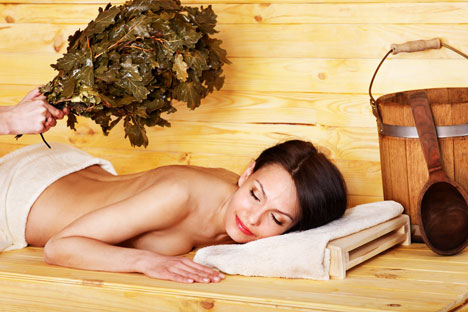
Being "beaten" with twigs is an essential part of the banya experience. Source: Lori / Legion Media
The banya, or bathhouse, used to be considered a sacred place because the unification of all the elements of nature was observed in it – water, air, fire, and earth. In olden times Russians believed that these elements were transferred to a person during the cleansing process and so made him strong and healthy.
Nowadays most people are no longer superstitious, but the tradition of going to the bathhouse not only has not died, but is becoming even more popular. The ritual of the banya involves steaming for long periods in a wooden chamber fitted with a small furnace, during which bathers take turns to beat each other with a venik, or besom – a birch switch intended to stimulate blood circulation.

“When foreigners enter our banyas, they are in a state of enthusiasm and excitement, but when they steam, they are in a state of shock,” Grigory Solovyov, the vice-chairman of the board of directors of Sanduny Baths, the oldest bathhouse in Moscow, told the Rossiya TV channel.
For a peasant in ancient Rus, the building of a domicile began with the construction of the bathhouse. As a rule, these were little log cabins with a door and one window located just below the ceiling.
The ‘black’ banya
The traditional type of Russian banya is the so-called ‘black’ banya. Due to the lack of a chimney, in such a sauna all of the smoke from the furnace escaped from openings in the roof and walls. Because of this, the ceiling and walls were always soot-stained, and had to be washed every time before a new washing.
Before steaming, all the doors and windows were opened wide to freshen the air. No one began the steam bath before all the smoke had dispersed; otherwise there was the possibility of smoke poisoning.
View the video by RBTH: How to stoke a Russian banya
But despite the difficulties in preparation, the ‘black’ bath was unique in its sterility; it can be compared to an operating theater and remains one of the most beneficial varieties of steam bath.
“Many bath attendants believe that the ‘black’ bath is the only real Russian banya. But ‘black’ baths are now only found in the depths of the north of the European part of Russia and in Siberia in villages,” says Anton Romanchenko, the manager of the Okhta bath center in Moscow.
The ‘white’ banya
Over time, the ‘black’ banya acquired a chimney and turned into the ‘white’ banya. A sauna furnace takes up a third of the space in such a bathhouse. It heats stones which sit atop the furnace, which in turn heat the steam room.
When the stones are warmed up, the fire is extinguished and damper pipe closed. Banya-goers then start steaming and move to the top ‘shelf’ of seating, where the steam is hotter. This is the most common type of bathhouse in Russia today.
However, these days you can also steam in a bathhouse on the go – in a specially equipped truck or van. The back of such a mobile banya is equipped with an oven and a boiler for water. The steam room is set up inside; there’s even a shower cabin. The wood furnace is kept outside for safety reasons. The interior of the bathhouse is sheathed in foil and boards for maximum heat retention.
“Once I was in a real Russian bathhouse,” says Yegor Chernegov-Nomerov, a bass singer and banya fan, who explains that such banyas can only be found in the hinterlands.
“When you’re deep in the taiga in a real steam bath, when they stoke the sauna properly, wrap up your head, soak the birch twigs and begin to lash you so that you run out into the snow, you dive into the icy water and realize how happy you are. This kind of thing can only be experienced in Russia,” he says.
Chernegov-Nomerov has been to many of the world’s most famous bathhouses and goes to Austria every winter in order to go to the local sauna, but even there he cannot forget about the emotions that the Russian banya brings.
“A bath attendant is also a doctor who takes an oath not to harm a guest or himself. This work is quite hard and includes serious physical loads,” the president of the International Association of the Art of Bath, Marat Khairov, told the Rossiya TV channel.
“The movement of the besom requires special medical knowledge. He must always keep track of the guest’s condition and decide when to give heat and when to lower it.”
All rights reserved by Rossiyskaya Gazeta.
Subscribe
to our newsletter!
Get the week's best stories straight to your inbox